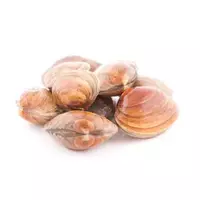Venerka mollusk (vongole)

The venerka mollusk (vongole) or vongole belongs to the species of mollusks in the structure of which there are dicotyledonous strong leaflets. In its shape, the mollusk venerka (vongole) is round and slightly elongated. Currently, there are two main species of venerka mollusk (vongole), which live mainly in the Mediterranean region.
Smaller molluscs are called cockerel venerkas or vongole comuni. Large individuals of the vongole mollusk are called Japanese lattice venerkas or vongole veraci. In turn, vongole veraci are divided into such subspecies as:
Tapes philippinarum;
Venerupis decussata;
Venerupis aurea;
Dosinia exoleta and others.
It is worth noting that the main difference between all subspecies of lattice Japanese mollusks lies in the habitat. Even experts with the naked eye will not be able to distinguish one subspecies of Japanese vongole from another. Venereka shells differ in color depending on the species of mollusk, and in addition, the habitat. The colors of the mollusk can range from dark brown to light blue or even dirty white.
Notably, the vongole shellfish leaflets have a heterogeneous color and may contain spots or patterns in the form of zigzags and stripes. The maximum recorded size of venera shells is 5 cm. Inside the vongole shell is the body of a mollusk, as well as the mantle. It is worth noting that the biological structure of the mollusk is interesting for the absence of the head and the presence of one leg, which helps the vongola to move.
Usually, the Venerka mollusk chooses for habitat the depth of which reaches 12 meters. Such a mollusk as Venus is collected on the coast of Tyrrhenian, as well as the Adriatic Sea at low tide. Venerka mollusk is especially popular and in demand in Italy. It is worth noting that, unlike oysters and mussels, the vongole mollusk is not cultivated, but is harvested exclusively in the so-called wild or natural habitat.
Interestingly, the Venerka mollusk is harvested both manually and commercially. Like all representatives of bivalve mollusks, venerki, due to their structure, pass seawater through their filters. For this reason, it is strictly forbidden to use the venereus mollusk raw so as not to get severe poisoning or intestinal infection.
The clam is used to make both cold snacks and hot main dishes. Marinated venerka mollusks are considered a real delicacy and recognized masterpiece of the Italian culinary tradition. Peeled venerks are used to make risotto, as well as seafood pastes. Venerka mollusk is not only tasty, but also all seafood is an incredibly healthy food product for humans, the chemical composition of which contains a large amount of vitamins, as well as macro- and microelements.
Venera mollusk (vongole) 86 kCal
Energy value of mollusk venerka (vongole) (Ratio of proteins, fats, carbohydrates - ju):
Proteins: 14.67 g (~ 59 kCal)
Fats: 0.96 g (~ 9 kCal)
Carbohydrates: 3.57 g (~ 14 kCal)
Energy ratio (bj | y): 68% | 10% | 17%
 Español
Español Français
Français Português
Português Русский
Русский 简体中文
简体中文 繁體中文
繁體中文 日本語
日本語 한국어
한국어 العربية
العربية Türkçe
Türkçe Қазақ
Қазақ Deutsch
Deutsch Italiano
Italiano Українська
Українська
